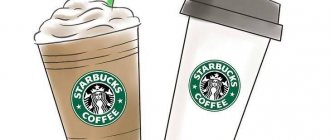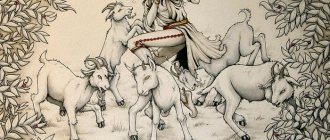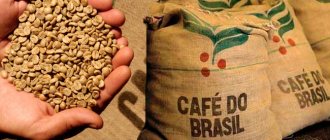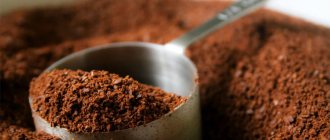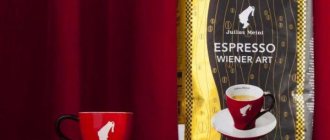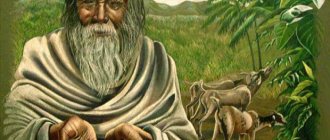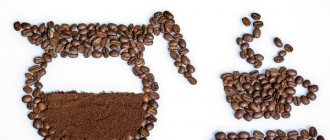Starbucks is one of the most famous chains of coffee shops and coffee outlets around the world. Today it is the largest coffee company in the world, with outlets in 66 countries around the globe. Starbucks is not inferior in its popularity to even the largest fast food restaurant chain McDonald's and is considered almost one of the symbols of America.
In this article, Elgreloo.com will tell you what is special about this company and why Starbucks coffee shops are so popular all over the world. You will also learn the history of the corporation and interesting facts about Starbucks.
Creation
Starbucks was founded in 1971 by three friends from Seattle:
- Jerry Baldwin, English teacher;
- Zev Seagle, history teacher;
- Gordon Bowker, writer.
They knew each other from their days at the University of San Francisco. The founders chipped in $1,350, borrowed another $5,000, and opened a store selling roasted coffee beans. For the first 9 months of operation, beans were purchased from Peet's Coffee, after which purchases began directly from farmers. The business was profitable, and soon Starbucks had its own roastery and a second outlet.
The enterprise turned into a chain of coffee shops with a different manager. By 1986, Starbucks had 6 of its own stores in Seattle, a small production facility, and an established mechanism for supplying coffee beans to bars, cafes, and restaurants. In 1987, former Starbucks marketing executive Howard Schultz bought the company from its founders and merged it with his own chain of coffee shops, Il Giornale. The combined enterprise began to develop under the name Starbucks. Already in 1992, the company had 165 retail outlets, at the same time it made an initial placement of its securities on the stock market.
By the end of 2021, the number of coffee shops around the world exceeded 24,000. A well-thought-out franchise scheme helped the company conquer the world.
“My friends, Gordon Bowker, Jerry Baldwin and I at that time often discussed and came up with interesting ideas for business, we all wanted to change our lives and do something big, meaningful and meaningful. We started meeting every few weeks to exchange ideas, and one day at lunch we ordered an espresso that turned out to be very bad,” Zev Siegl in an interview with The Guardian, 2021.
Jerry Baldwin, Gordon Bowker, Zev Seigl
Stages of company development
In the early 1980s, sales of regular coffee in the United States began to decline, and demand for specialty coffee, which the company specialized in, grew. In an environment of rapid growth, Starbucks owners were unable to effectively manage their business. In addition, in 1980, Zev Zigal left the company. Therefore, in 1982, businessman Howard Schultz came to Starbucks to put the business in order and ensure its growth.
After a trip to Milan and getting acquainted with the European culture of coffee consumption, G. Schultz proposed changing the concept of the company, which had previously sold only beans, and opening several coffee bars. The Starbucks coffee shop, which became the company's 6th outlet, quickly became one of the most popular establishments in the city. Soon G. Schultz opened another coffee shop, “Il Giornale,” which within 2 months served over 700 visitors.
Despite this success, the owners of Starbucks were not ready to move into the restaurant business niche. In 1987, G. Schultz gathered a group of investors who bought the company from the owners for $3.7 million. All coffee shops became Starbucks, and stores selling coffee beans became cozy coffee shops. The company itself was named “Starbucks Corporation”. By the end of the year, the company already operated 17 points of sale.
You can watch the biography of Howard Schultz in the video.
In 1988, the company was one of the first in the industry to begin publishing its own catalog, which helped it establish cooperation with more than 30 stores, and implemented the delivery of goods by mail. In the same year, the expansion of neighboring states began - Starbucks coffee shops appeared in Chicago, Portland and Vancouver.
Over the course of 4 years, the company opened about 150 more retail outlets, and in 1992, there were already 165 Starbucks stores and coffee shops operating in the United States. The company's income exceeded $73 million. In the same year, a public offering of the company's shares was carried out, as a result of which the market valued Starbucks at $271 million. 12% of the shares sold brought $25 million in profit, which was invested in expanding the network. Just 3 months after the shares were placed, their price increased by 70%.
1996 - the beginning of the international expansion of the brand. The first country was Japan. A little later, the company's coffee shops appeared in Singapore, Taiwan and South Korea.
In 1998, Starbucks appeared in England. It was decided to enter the British market through the purchase of a large local company, Seattle Coffee Company, which operated 56 points of sale. The deal is valued at $83 million.
During this period, the company's management initiates the creation of new products and signs several deals aimed at increasing the popularity of the brand:
- the company's products began to be offered on United Airlines planes;
- selling coffee via the Internet;
- sale of coffee through large retail chains.
In 2002, Starbucks entered the Latin American market. The first store was opened in Mexico City. Today, the company operates over 250 locations throughout Mexico.
By early 2007, there were approximately 16,000 Starbucks coffee shops operating in more than 40 countries around the world. The company began selling snacks, accessories and devices for serving and preparing coffee.
Interesting fact! Despite the large number of establishments under management, the company makes sure that the entrance doors of coffee shops do not face north. This is done so that the sunlight does not interfere with the visitors’ enjoyment of coffee.
In 2008, the company entered the markets of Europe and South America, which became the main areas of brand development. At the same time, the company closed 70% of its stores in Australia (due to the difficulty of learning the local coffee culture) and experienced difficulties operating in China.
The global financial crisis significantly worsened the company's performance and at the end of 2008, Starbucks shares were trading at $4–5 per share. But successful business development in Europe and Latin America in 2009–2012. became the reason for the good growth in the value of the company’s shares, which by the beginning of 2013 were already selling at $27/piece.
You can watch the success story of Starbucks in the video.
Starbucks logo
The coffee chain's name was borrowed from Herman Melville's novel Moby Dick. Captain Ahab's mate was named Starbuck. When creating the logo, a marine theme was also used. It depicts a siren - half-woman, half-fish, luring sailors with her beauty and mesmerizing singing.
The original image of a half-naked mermaid was taken from a 16th-century engraving. The designer did a little work on the character - they added a smile to him and removed his belly button. In 1987, green became the dominant color in the logo instead of brown. In 1992, the lower part of the siren's body was removed, and in 2011, nothing remained on the sign except a mythological creature in a green circle.
Why is Starbucks so popular in the world and why is it not in Belarus?
The largest chain of coffee shops, Starbucks, is rightfully considered one of the symbols of America. Today, one in five cups of coffee is drunk at Starbucks in the United States, but Howard Schultz, the owner and mastermind of the company, had to work hard to instill in Americans a love for this exquisite drink.
The story of three coffee lovers
In 1971, English teacher Jerry Baldwin, history teacher Zev Siegl, and writer Gordon Bowker each pooled $1,350, borrowed another $5,000, and opened a coffee bean store in Seattle, Washington.[3] When choosing a name for the store, the name of the whaling ship from Herman Melville's novel "Moby Dick" - "Pequod" was first considered, but in the end it was rejected, and the name of Ahab's first mate? -?Starbuck was chosen. The logo was a stylized image of a siren.
The partners learned the correct selection of varieties and roasting of coffee beans from Alfred Peet, owner of Peet's Coffee. Starbucks bought beans from Peet's Coffee for the first 9 months of operation, and then the partners installed their own roaster and opened a second store.
By 1981, there were 5 stores, a small coffee roasting factory and a trading division that supplied coffee beans to bars, cafes, and restaurants.
In 1979, the owners of Starbucks bought Peet's Coffee.
The store opened during a difficult period: at the end of the 60s, Americans were completely disillusioned with instant coffee, and most of them simply did not know that there was any other coffee besides instant. Therefore, there really weren’t many buyers.
Romantic Howard Schultz
Howard Schultz became one of Starbucks' true believers. Having tried Starbucks coffee, he immediately fell in love with it, because this coffee had nothing in common with what he had tried before.
[+] Schultz later recalled: “I went out into the street, whispering to myself: “My God, what a wonderful company, what a wonderful city. I want to be a part of them."
After leaving his post as CEO of the New York division of the tableware company Perstorp AB, Howard Schultz came to work at Starbucks.
He directed all his efforts to the development of the new company, but business was not going as well as he wanted. In total, Starbucks had only a few thousand regular customers.
1984 was a turning point in the history of the company. Once in Italy, Schultz discovered a completely new culture of coffee consumption. Unlike Americans, Italians drank coffee not at home, but in cozy coffee shops.
[+] The idea of drinking coffee outside the home literally inspired Schultz.
He suggested that the owners of Starbucks open a coffee shop, but the proposal did not find support. The management was of the opinion that real coffee should be prepared at home.
But nothing could stop Schulz, and in 1985 he founded his own coffee shop, II Gionale. Things went so well that after 2 years he bought Starbucks from its founders for $4 million.
Bar counters appeared in all the company's stores, where professional baristas (coffee preparation specialists) ground coffee beans, brewed and served aromatic coffee.
The baristas knew all the regular customers by name and remembered their tastes and preferences. But even such impeccable service could not overcome the conservatism of the Americans: they were still not ready to drink real bitter coffee.
[+] Then Howard Schultz decided to make light roast coffee—?lighter and more familiar to the average American. And this brought success to his business: America fell in love with this coffee.
Starbucks coffee shops received more and more visitors, and coffee sales in stores remained at the same level. This is how the company’s main business turned into a side business.
Meeting point
The popularity of Starbucks inspired not only consumers, but also competitors. Similar coffee shops began to open everywhere, but with lower prices. Even fast food restaurants and gas stations have started advertising "Espresso" to lure customers.
It was important for Starbucks to maintain its uniqueness. The company relied on positioning and announced its principles: romance, luxury for everyone, tranquility and an informal atmosphere.
Following its stated benefits, Starbucks is completely changing the format of coffee shops, turning them into the best place to socialize.
The area of the establishments has increased tenfold, and high bar stools at the counter have been replaced by cozy tables. With the ability to sit apart from other customers, Americans began making appointments at Starbucks.
[+] Howard Schultz wanted his chain of coffee shops to not just sell coffee, but to have a special atmosphere, becoming a third place between work and home.
In America, Starbucks has become the epitome of democratic coffee shops for a new generation of customers—educated and with good taste.
[+] Howard Schultz emphasized that his business is not to fill stomachs, but to fill souls. This is the secret to Starbucks' success.
Uncompromising quality
Starbucks' popularity continued to grow, but the company found it increasingly difficult to combine a wide variety of products with high quality products.
The fact is that Starbucks delivered the beans in special packaging—two-kilogram bags. As long as the bag was closed, the coffee retained its original freshness, but the opened bag had to be used within 7 days. This was unacceptable for rare and expensive coffees.
Starbucks found a way out here too. The company created its own technology for producing powdered coffee and, as a result, developed instant coffee that is as close as possible to natural coffee. The quality of the coffee was not affected, and the cost issue was successfully resolved.
In the 90s, America was already overwhelmed by a real coffee mania and obsession with Starbucks. The company was growing at a breakneck pace—up to 5 new coffee shops were opening every day. By the end of the 1990s, Starbucks had more than 2,000 locations and was gaining recognition in Japan and Europe.
At the same time, the idea of healthy eating is gaining momentum in California, the richest and most populous state in the United States. Californians began to count every calorie and decided that drinks made with full-fat whole milk were unhealthy.
At first, Starbucks resisted the fashion trend, fearing that skim milk would not allow the coffee to retain the same taste.
Diet coffee wasn't introduced until the company started losing customers. This is how drinks appeared on the menu, devoid of the taste of real coffee, but satisfying the tastes of consumers who care about their health.
Starbucks' business was running like clockwork, and in 2000, Howard Schultz decided to step away from direct management of the company to pursue new business projects.
By 2005, Starbucks had grown into a global chain with more than 8,300 coffee shops. By the end of 2007, 15,700 Starbucks coffee shops had already been opened in 43 countries. The company's revenues for 2007 amounted to $9.4 billion.
[+] Starbucks' fame has reached such a level that The Economist magazine introduced a "Starbucks Index", similar to the popular "BigMack Index".
This index is an indicator of the economic situation in the country and is determined by the price of a standard cup of coffee at Starbucks.
Return of the Leader
In 2007, the situation at Starbucks began to seriously concern Howard Schultz: coffee shop patrons complained of a “loss of the spirit of romance.” Schultz knew perfectly well what was going on, and repeatedly drew the attention of the company’s top managers to the fact that:
- new machines for brewing coffee were higher than the previous ones, and this did not allow customers to monitor the process of preparing the drink;
- The new packaging preserved the beans well, but deprived the coffee shops of the subtle aroma that was so attractive to coffee connoisseurs.
In early 2008, Howard Schultz returned to leadership to restore the company's image. The economic crisis also made additional adjustments: optimizing costs, the company closed 600 coffee shops in 2008 and another 300 in 2009.
Now all the company’s efforts are aimed at overcoming the consequences of the crisis and improving service. Starbucks is actively helped in this by its customers by publishing their reviews and suggestions on the website.
Interesting facts about Starbucks
- The company logo was an image of a siren with a bare chest and navel. The image of the siren symbolizes that Starbucks coffee comes from the far corners of the world. The original Starbucks logo can still be seen on the first store in Seattle.
- Schultz was advised to unite coffee shops and stores under one Starbucks name by Bill Gates , founder of Microsoft and one of the company's first investors.
- Starbucks locations always meet the following requirement: the front door faces east or south, never north. Visitors should enjoy daylight without being disturbed by it.
- The music played in Starbucks coffee shops spans its entire network: the composition that you hear in New York is playing at the same minute in Seattle. Moreover, each coffee shop has a unique interior design and atmosphere.
- A year ago, Starbucks joined the AIDS Foundation's (PRODUCT) RED™ program, donating a percentage of its profits to research and treatment of the virus in Africa.
- Over the course of the year, the company collected donations that will be enough for 7 million days of medical support for HIV-infected people in Africa.
Quotes by Howard Schultz
“We just didn’t know it couldn’t be done, so we did it.”
“We believe that business should mean something. It must be based on some original product that exceeds the client’s expectations.” “Coffee without people? is a theoretical concept. People without coffee?—?also neither this nor that.” “If we consider a butterfly, based on the laws of aerodynamics, it should not be able to fly. But the butterfly doesn’t know this, that’s why it flies.” “Dreaming is one thing, but when the moment comes, you have to be willing to leave your normal life and start searching for your own sound.” “If you say you never had a chance, maybe you just didn't take it.” 4 2 votes Rating
Starbucks drinks
The first Starbucks coffee shops offered several varieties of lattes and espressos. Howard Schultz brought many of the recipes from a trip to Italy, where he really liked the culture of coffee drinking. Following the hot ones, the assortment also included cold coffee drinks, including several types of Frappuccino. The main menu also includes about 10 types of tea - black, green, herbal, with and without caffeine. Specific recipes are distributed in certain regions, so a regular Starbucks customer in another country can often try something new.
In addition to drinks, the company sells its own baked goods and snacks, and continues to maintain its long-standing coffee bean business.
History of the name
One of the founders, writer Gordon Bowker, was an ardent fan of the famous novel Moby Dick. Perhaps he himself dreamed of taking away laurels from Herman Melville in a similar genre, or in his spare time, throwing a harpoon on a whaling ship. So, in this novel, all the action took place on the whaling ship “Pequod” (they wanted to give the coffee shop exactly that name, but the guys came to their senses in time), and the first mate on the ship was called Starbuck. Therefore, the company liked this combination of the word “Starbo” (a local old mine) and the name of the beloved hero. The result is a name that we all know and won’t confuse with anything else.
Starbucks corporate culture
Despite the fact that Howard Schultz was in charge of the overall management of the company, there were two other important people at its helm:
- Howard Behar, president of Starbucks International;
- Orin Smith, Chief Financial Officer.
The three heads worked so harmoniously that they were called H₂O by the first letters of their names - Howard, Howard and Orin.
Howard Behar wrote the book It's Not About the Coffee: The Corporate Culture of Starbucks, which is often listed on popular business literature lists. Its main idea is that a company needs to consider both employees and customers, first of all, as people. If this principle is followed, then everything else will come by itself.
How Starbucks works
As it turns out, most people don't go to Starbucks for coffee. Of course, everyone who has ever heard of this famous chain of coffee shops wants to try the taste of coffee from a global brand. But surveys show that customers go to Starbucks for the atmosphere.
In fact, this is not an accident. After all, this is what the corporation’s marketers are constantly working on. Howard Schultz himself is confident that people come not only for a drink, but also for a personal experience - to chat, meet friends, work or just sit in a pleasant place with a cup of coffee. Therefore, the Starbucks team is trying its best to create a favorable environment for this.
By the way, it’s interesting that Schultz coined the term “third place.” It denotes the place that is in the middle between work and home (the places where we spend most of our time). It is on this concept that the entire Starbucks business is built - to fill souls, not stomachs.
Apart from this, people are attracted by the personal touch of the brand. A simple example is when you buy coffee at Starbucks, your cup will have your name written on it. It's a small thing, but nice. And this also played a huge role in the brand's appeal.
Another important point in Starbucks’ corporate policy is open, friendly communication between staff and visitors. It is unlikely that a silent person will be hired as a barista, no matter how professional he is. The priority is communication skills and a good attitude under any conditions. By the way, in the 2000s, this concept came under threat when the company purchased new coffee machines. They were so large that they blocked the baristas, so they could not communicate with customers. To solve this problem, we had to redo the bar counters and lower the devices lower.
We hope you found this article from Elgreloo.com interesting. If you know any other interesting facts about Starbucks, share them with us in the comments!
Starbucks franchise
The Starbucks empire is too big to be owned by one company. Today only 30% of establishments belong to the parent company, the rest operate as franchises. At the same time, management puts reputation first, which is why many applicants are rejected. Almost everything is controlled: the size of the room, its location and the location of the entrance doors, the interior, the menu and even the music playing in the hall.
Interesting facts about Starbucks
- Today there are more than 21 thousand Starbucks coffee shops in the world. At the same time, on average, two new retail outlets open every day.
- The company says there are more than 87,000 different Starbucks drinks available today. There are about 36,000 Frappuccino combinations alone, so to try them all, you'd have to order 5 cups every day for 47 years.
- A cup of Starbucks coffee contains 320 milligrams of caffeine, which is four times the content of a Red Bull energy drink.
- Every year, Starbucks coffee shops around the world use about 4 billion cups.
- When Steve Jobs introduced the new iPhone in 2007, he called Starbucks to show off all the capabilities of his device.
- Howard Schultz, the current owner of the company, is always trying to make his coffee shops better. When he learned that his customers liked the music in the cafe and often asked where they could find it, he released a CD of jazz and blues. It is worth noting that on the first day of sales more than 75 thousand discs were sold.
- The front doors of any Starbucks coffee shop face east or south. However, you will not find a point where the front door faces north. Everything is done to ensure that visitors enjoy the daytime sun, but it does not blind their eyes.
- Starbucks pays its landlords one dollar a year. This does not apply to everyone, but the corporation knows that no one will be left without profit. Even the most impassable places will become profitable spots, because people will want to come to Starbucks for the atmosphere and their favorite coffee.
Now let's take a closer look at this iconic company and find out how it gained its popularity and gained a positive reputation around the world.
Starbucks in Russia
Starbucks coffee shops came to our country quite late. The delay turned out to be due to a legal dispute - Starbucks LLC, which had nothing to do with the chain, appeared in the Russian Federation and registered the right to use this brand in Russia. As a result, the American corporation first had to fight for its own rights.
The first coffee shop in the Russian Federation was opened in September 2007 in the Mega-Khimki shopping center. Today there are about a hundred network points operating in the country, most of them are located in Moscow.
Starbucks Museum
The very first Starbucks location, opened back in 1971 in Seattle, still retains its original appearance. Sometimes renovation work is carried out there, however, the interior and decoration are not touched. It is the same as it was in 1971. Many people call it the “Starbucks Museum,” although there are no museum exhibits there.
Sources
- https://coolbusinessideas.info/istoriya-uspexa-starbucks/
- https://zen.yandex.ru/media/id/5b7228889be7c200a841ab81/predlagaem-vashemu-vnimaniiu-istoriiu-uspeha-kompanii-starbucks-5c0247f6dc4f7003dd2b01b0
- https://realnoevremya.ru/articles/129807-istoriya-starbucks-corporation
- https://www.profvest.com/2020/02/istoriya-kompanii-starbucks.html
- https://coffexpert.ru/starbucks/
- https://americanbutler.ru/ru/polezno/brendy/starbucks
- https://dengodel.com/interesting/sekrety-uspeha-starbucks.html
- https://BroDude.ru/kofejnye-istorii-uslyshat-ne-xotite-li/
- https://turbologo.ru/blog/starbucks/
- https://logolove.me/the-history-starbucks-logo/
- https://coffevsem.ru/biznes-chaj-kofe/starbaks-chto-eto-takoe.html
